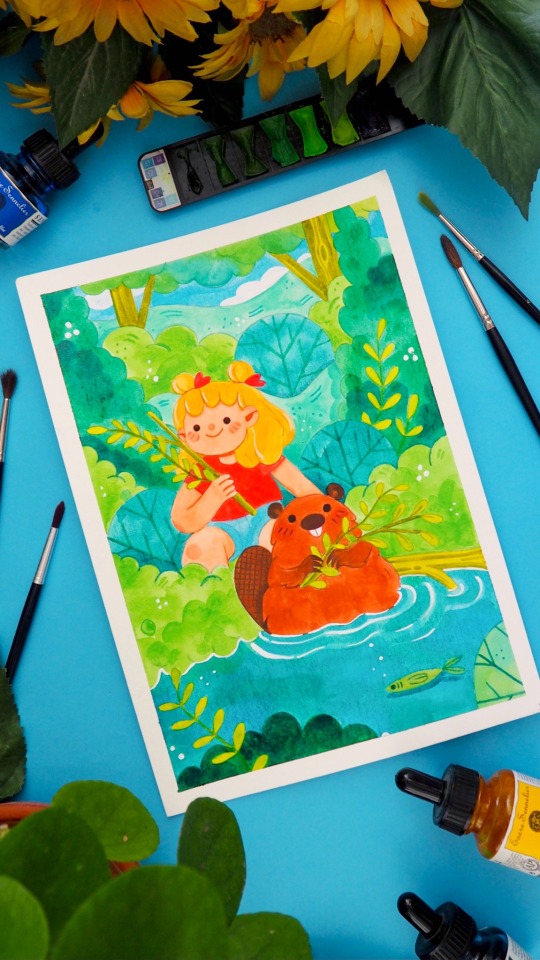Beaver 🌿🦫 🩵 + Watercolor And Ink Process


Beaver 🌿🦫 🩵 + watercolor and ink process
More Posts from Mlu and Others

It’s Andor Time! Do you have a question for the cast of Andor? They may have answers!
Submit your questions here, and come back for their Answer Time on September 21st at 12pm PT / 3pm ET.

Tableau de bord de la Citroën Éole, 1985
Another idea: Communities on Tumblr
For a while now folks have asked us for better ways to connect with other people who share similar interests. We’re listening, and at Labs we’ve been looking into fulfilling that need, Tumblr style.
Introducing Communities, a new place to connect with others on Tumblr:

Here in Labs, we’re working on big ideas that could transform how Tumblr is used, while keeping that Tumblr vibe alive. You can see one of those ideas above. We’re calling it “Communities”, a new dedicated space on Tumblr for people to share and discuss all the content they love. Communities can cover topics like your favorite show, artist, movie, video game, your school, your board game group, friend group, big or small, whatever you want.
Each Community has their own semi-private safer space away from the regular dashboard where you can interact with other Tumblr users who share the same interests and passions as you. There are moderators and members (you!), rules, and privacy settings. Each community has its own feed of posts from members, separate from your Following and For You feeds. Interactions within community spaces stay there and replies will work more like a traditional comment section. Folks will be able to reblog posts into a community, but not out — at least not yet.
We’re very excited for you to try it, and help define the best path forward. What we have is a prototype to help us validate the idea, but there’s still plenty of questions that need answering. Over the next couple of weeks, we’ll be reaching out to people across Tumblr, and the internet at large, to try our prototype. Based on the feedback we get, we’ll iterate on the idea to see what resonates best with all of you on Tumblr.
If this sounds interesting, please like, reblog, or reply to this post, and we’ll invite you to beta test this feature when we roll it out to a wider Tumblr audience, as a little perk for following the Labs blog.
Stay tuned for more!







Mars Helicopter: 6 Things to Know About Ingenuity

When our Perseverance Mars rover lands on the Red Planet on Feb. 18, 2021, it will bring along the Ingenuity helicopter.
This small-but-mighty craft is a technology demonstration that will attempt the first powered, controlled flight on another planet. Its fuselage is about the size of a tissue box, and it weighs about 4 pounds (1.8 kg) on Earth. It started out six years ago as an implausible prospect and has now passed its Earthbound tests.
Here are six things to know about Ingenuity as it nears Mars:
1. Ingenuity is an experimental flight test.

This Mars helicopter is known as a technology demonstration, which is a project that aims to test a new capability for the first time with a limited scope. Previous technology demonstrations include Sojourner, the first Mars rover, and the Mars Cube One (MarCO) CubeStats that flew by Mars.
Ingenuity does not carry any science instruments and is not part of Perseverance’s science mission. The only objective for this helicopter is an engineering one – to demonstrate rotorcraft flight in the thin and challenging Martian atmosphere.
2. Mars won’t make it easy for Ingenuity.

Mars’ atmosphere is around 1% the density of Earth’s. Because of that lack of density, Ingenuity has rotor blades that are much larger and spin faster than a helicopter of Ingenuity’s mass here on our planet. It also must be extremely light to travel to Mars.
The Red Planet also has incredibly cold temperatures, with nights reaching minus 130 degrees Fahrenheit (-90 degrees Celsius) in Jezero Crater, where our rover and helicopter will land. Tests on Earth at the predicted temperatures indicate Ingenuity’s parts should work as designed, but the real test will be on Mars.
3. Ingenuity relies on Perseverance for safe passage to Mars and operations on the Martian surface.

Ingenuity is nestled sideways under Perseverance’s belly with a cover to protect the helicopter from debris during landing. The power system on the Mars 2020 spacecraft periodically charges Ingenuity’s batteries during the journey to the Red Planet.
In the first few months after landing, Perseverance will find a safe place for Ingenuity. Our rover will shed the landing cover, rotate the helicopter so its legs face the ground and gently drop it on the Martian surface.
4. Ingenuity is smart for a small robot.

NASA’s Jet Propulsion Laboratory will not be able to control the helicopter with a joystick due to delays communicating with spacecraft across interplanetary distances. That means Ingenuity will make some of its own decisions based on parameters set by its engineering team on Earth.
During flight, Ingenuity will analyze sensor data and images of the terrain to ensure it stays on a flight path designed by project engineers.
5. The Ingenuity team counts success one step at a time.

Ingenuity’s team has a long list of milestones the helicopter must pass before it can take off and land in the Martian atmosphere.
Surviving the journey to and landing on Mars
Safely deploying onto the Martian surface from Perseverance’s belly
Autonomously keeping warm through those intensely cold Martian nights
Autonomously charging itself with its solar panel
Successfully communicating to and from the helicopter via the Mars Helicopter Base Station on Perseverance
6. If Ingenuity succeeds, future Mars exploration could include an ambitious aerial dimension.

The Mars helicopter intends to demonstrate technologies and first-of-its-kind operations needed for flying on Mars. If successful, these technologies and flight experience on another planet could pave the way for other advanced robotic flying vehicles.
Possible uses of a future helicopter on Mars include:
A unique viewpoint not provided by current orbiters, rovers or landers
High-definition images and reconnaissance for robots or humans
Access to terrain that is difficult for rovers to reach
Could even carry light but vital payloads from one site to another
Make sure to follow us on Tumblr for your regular dose of space: http://nasa.tumblr.com

me @ France right now

how does tumblr even work do you just like talk to yourself until people are like "i like this one"

-
 damian0358 reblogged this · 10 months ago
damian0358 reblogged this · 10 months ago -
 vampiric-ish reblogged this · 1 year ago
vampiric-ish reblogged this · 1 year ago -
 mysticusfreeze reblogged this · 1 year ago
mysticusfreeze reblogged this · 1 year ago -
 mysticusfreeze liked this · 1 year ago
mysticusfreeze liked this · 1 year ago -
 lipglossangel reblogged this · 1 year ago
lipglossangel reblogged this · 1 year ago -
 hukat7 liked this · 1 year ago
hukat7 liked this · 1 year ago -
 noisersystem liked this · 1 year ago
noisersystem liked this · 1 year ago -
 tarka-illustration liked this · 1 year ago
tarka-illustration liked this · 1 year ago -
 shiuefha liked this · 1 year ago
shiuefha liked this · 1 year ago -
 sharktea4-0 liked this · 1 year ago
sharktea4-0 liked this · 1 year ago -
 bellebirdsart liked this · 1 year ago
bellebirdsart liked this · 1 year ago -
 quitecartoonist liked this · 1 year ago
quitecartoonist liked this · 1 year ago -
 small-toad liked this · 1 year ago
small-toad liked this · 1 year ago -
 weblackbell liked this · 1 year ago
weblackbell liked this · 1 year ago -
 godsleastfav123 liked this · 1 year ago
godsleastfav123 liked this · 1 year ago -
 yesidoodles liked this · 1 year ago
yesidoodles liked this · 1 year ago -
 argopourpaintings liked this · 1 year ago
argopourpaintings liked this · 1 year ago -
 whattheheckins liked this · 1 year ago
whattheheckins liked this · 1 year ago -
 mlu reblogged this · 1 year ago
mlu reblogged this · 1 year ago -
 mlu liked this · 1 year ago
mlu liked this · 1 year ago -
 thekach22-blog liked this · 1 year ago
thekach22-blog liked this · 1 year ago -
 addictedpony reblogged this · 1 year ago
addictedpony reblogged this · 1 year ago -
 ministreliya1808 liked this · 1 year ago
ministreliya1808 liked this · 1 year ago -
 artdavidrolea liked this · 1 year ago
artdavidrolea liked this · 1 year ago -
 anything-but-the-kitchen-sink liked this · 1 year ago
anything-but-the-kitchen-sink liked this · 1 year ago -
 ceriseeone liked this · 1 year ago
ceriseeone liked this · 1 year ago -
 aguatemalacomics liked this · 1 year ago
aguatemalacomics liked this · 1 year ago -
 trinns liked this · 1 year ago
trinns liked this · 1 year ago -
 oliviermira234 reblogged this · 1 year ago
oliviermira234 reblogged this · 1 year ago -
 oliviermira234 liked this · 1 year ago
oliviermira234 liked this · 1 year ago -
 ninjonnyuszi liked this · 1 year ago
ninjonnyuszi liked this · 1 year ago -
 msbeliever6 liked this · 1 year ago
msbeliever6 liked this · 1 year ago -
 sushilis liked this · 1 year ago
sushilis liked this · 1 year ago -
 taxi-davis liked this · 1 year ago
taxi-davis liked this · 1 year ago -
 pyjingopresents liked this · 1 year ago
pyjingopresents liked this · 1 year ago -
 wysoh liked this · 1 year ago
wysoh liked this · 1 year ago -
 wysoh reblogged this · 1 year ago
wysoh reblogged this · 1 year ago -
 acelceva liked this · 1 year ago
acelceva liked this · 1 year ago -
 lumanis liked this · 1 year ago
lumanis liked this · 1 year ago -
 somethingtrivial liked this · 1 year ago
somethingtrivial liked this · 1 year ago -
 doodle-girl reblogged this · 1 year ago
doodle-girl reblogged this · 1 year ago -
 ippo82 liked this · 1 year ago
ippo82 liked this · 1 year ago -
 madfatandhungry reblogged this · 1 year ago
madfatandhungry reblogged this · 1 year ago -
 dragonsrainbows liked this · 1 year ago
dragonsrainbows liked this · 1 year ago

Human | Earth | Tumblr Staff | ~ 30 Earth-Sol revolutions | My nucleobases are A/T/C/G
240 posts
